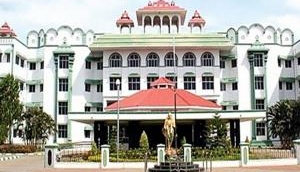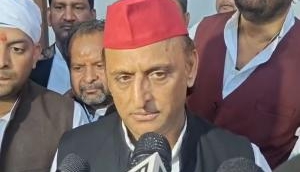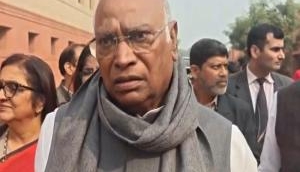
On November 9, 2019, five-judge constitutional bench headed by CJI Ranjan Gogoi and includes justices SA Bobde, DY Chandrachud, Ashok Bhushan and S Abdul Nazeer, pronounced its historic verdict on a batch of a petition against the 2010 Allahabad High Court order in the politically-sensitive Ramjanmbhoomi-Babri Masjid land dispute case.
The apex court ruled that possession of Ayodhya's contested property will vest in a trust to be formed by the central government and also directed that representation in the trust may be given to Nirmohi Akhara, a litigant in the case.
Here is a timeline of the second-lengthiest case:
1528: Babri Mosque built by Mughal emperor Babur's commander Mir Baqi
1885: Mahant Raghubir Das files a petition in the Faizabad District Court, seeking permission to build raise a structure next to the mosque. The plea is rejected.
1949: Idol of Lord Ram, Goddess Sita found inside the mosque by unknown persons. Hindus call it divine appearance and start offering prayers.
1950: Two suits filed in a Faizabad court by Gopal Simla Visharad and Paramhansa Ramachandra Das, seeking permission to worship the idols at the mosque
1959: Nirmohi Akhara, a party in the case in the Supreme Court, files suit seeking possession of the site
1981: Uttar Pradesh Sunni Central Waqf Board files suit for possession of the site and removal of idols from the mosque
1986: A local court orders opening of the site and allows Hindus to offer prayers.
1989: The Allahabad High Court orders status quo on the site. Rajiv Gandhi government at the Centre lets Vishwa Hindu Parishad (VHP) perform shilanyaas for Ram Temple.
1990: BJP leader Lal Krishna Advani starts Rath Yatra from Gujrat to gather support for the temple.
1992: Babri Mosque structure demolished by karsewaks
1993: The Central passes an Act to acquire land in and around the disputed site in Ayodhya.
1994: In the Ismail Faruqui case, the Supreme Court rules that the mosque is not integral to Islam
2002: The Allahabad High Court starts hearing to adjudicate the ownership of the disputed site.
2003: The Supreme Court bars any religious activity at the site.
2010: The Allahabad High Court rules trifurcation of the 2.77-acre disputed land between UP Sunni Waqf Board, the Nirmohi Akhara and Ram Lalla Virajman.
2011: The Supreme Court stays the High Court order
2016: BJP leader Subramanian Swamy files plea in the Supreme Court seeking permission to worship and construction of Ram Temple at the disputed site.
2018: The Supreme Court rejects all interim pleas, including that of Swamy, seeking to intervene as parties in the case. Advocate Rajeev Dhavan files plea in the court requesting it to refer the issue of reconsideration of its 1994 judgement to a larger bench which is denied. The court forms a three-judge bench instead to hear the case.
January 2019: Chief Justice Ranjan Gogoi constitutes a five-judge Constitutional Bench to hear the case
March 2019: The Supreme Court appoints a mediation panel headed by Judge (retd) FMI Kallifulla for an out-of-court settlement on March 8.
August 2019: The mediation panel fails to reach an amicable settlement. The Supreme Court begins hearing on August 6.
Oct 2019: After hearing the case on a day-to-day basis for 40 days, the court reserves its order on October 15.
What does the Allahabad HC verdict in 2010 say?
In September 2010, the Allahabad HC ruled a three-way division of the disputed area between Sunni Waqf Board, the Nirmohi Akhara and Ram Lalla.
Ram Chabutra and Sita Rasoi nearby went to the Akhara.
The Muslim side was left to take their one third after partition and adjustments from the extra land in and around, acquired by the govt. Each side was expected to give entry and exit rights to the other. The 3 parties moved the SC.
Possession of disputed land will be handed over to the deity Ram Lalla, one of the three litigants in the case.
Here are the five key points from the judgment:
-The disputed site has been given to the Ram Janmabhoomi Nyas and the centre has been asked to build a trust for the construction of the temple.
- SC directs allotment of alternative land to Muslims to build new mosque.
- Suitable land of 5 acre to be handed over to Sunni Waqf board at prominent place for building the mosque.
- Centre to frame scheme within 3 months and set up a trust for construction of a temple.
- SC dismisses plea of Nirmohi Akhara seeking control of entire disputed land.
- Centre, UP govt can monitor together future actions by authorities.
(With Inputs from Agencies)
Also Read: Kartarpur Corridor: Prime Minister Modi thanks Pak PM Imran Khan for respecting Indian







![BJP's Kapil Mishra recreates Shankar Mahadevan’s ‘Breathless’ song to highlight Delhi pollution [WATCH] BJP's Kapil Mishra recreates Shankar Mahadevan’s ‘Breathless’ song to highlight Delhi pollution [WATCH]](https://images.catchnews.com/upload/2022/11/03/kapil-mishra_240884_300x172.png)

![Anupam Kher shares pictures of his toned body on 67th birthday [MUST SEE] Anupam Kher shares pictures of his toned body on 67th birthday [MUST SEE]](https://images.catchnews.com/upload/2022/03/07/Anupam_kher_231145_300x172.jpg)






